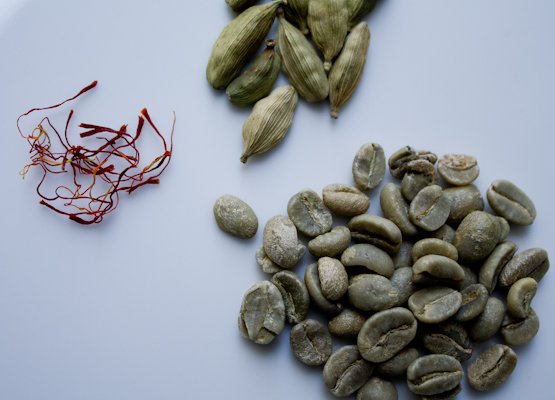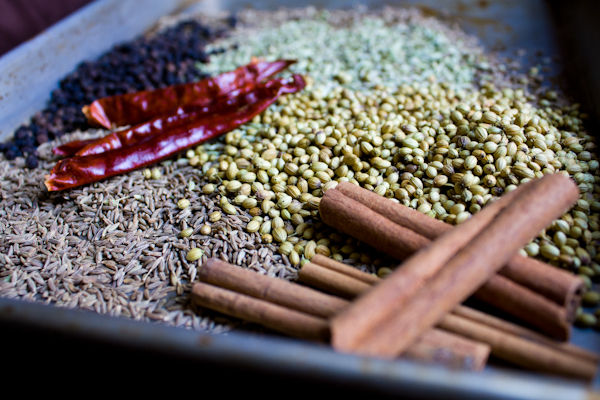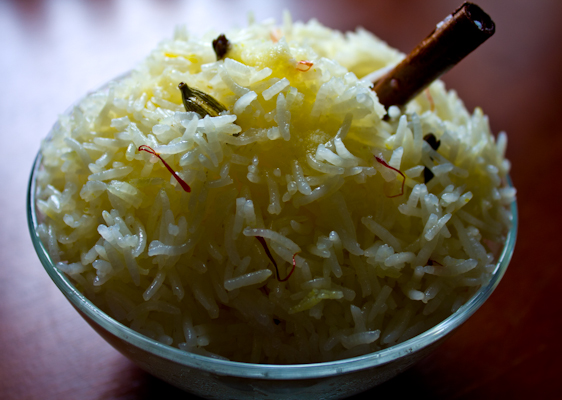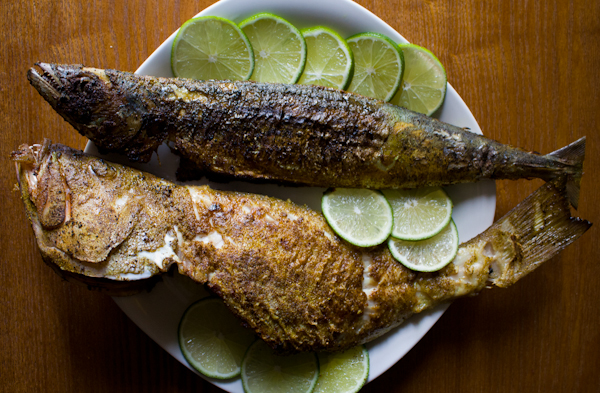Kingdom of Bahrain
We’re going to do something crazy today and have coffee before we eat. Coffee, or qahwa, is the cornerstone of Arab hospitality, and is served upon a guest’s entry into a home. Drink less than three cups and you will be labeled a jerk, or worse. This is a big, big, huge, massive deal in the Arab world, of which Bahrain is a part.
Once upon a time, I taught English for a very.. erm… important Saudi. I’m seriously uneasy to go into much detail about this – I’ll just say that armed guards and the biggest apartment I have ever seen were involved. Eh? You follow me? My student and her husband were so sweet, so hospitable, so gracious… it was an amazing experience in my life, and a friendship that I will never forget.
Anyway, absolutely every single time I went to teach my student, I was served plenty of qahwa, so it’s a flavor that I’m very familiar with, although I haven’t tasted it in a few years. I think there was only one time that I refused a cup, and I was met with such a sad response that I never again turned down a drop.
How do you make it, you ask? Well, I should be really specific about this part – qahwa is not really very much like coffee you’ve had anywhere else. It’s toasted right before it’s ground and steeped, and only very lightly at that. This gives it a greenish/light-brown color and a taste that is more like a tea than American, European or Turkish coffee. Authentic qahwa also includes a potpourri of lovely aromatics like saffron and rosewater that can be overwhelming at first, but by the third cup settles pleasingly into a comfortable, warming flavor.
Making it the ceremonial way involves a series of soakings in four separate vessels, and then a decanting into a decorative coffee pot, and then a very short pour into a tiny cup, which is constantly refilled by the host. The tiny cup makes sense – if you were required to drink a minimum of three Venti soy lattes every time you visited someone, you’d probably always be peeing your pants and never sleeping.
Here’s what I did, in short:
I toasted the coffee in the oven for just a few minutes, until it was a light brown color, like peanut butter. Then I cooled the beans, and finally ground them in a coffee grinder. This is harder than it sounds – there is still a lot of moisture left in these sort-of-raw beans, which means a clumpy, coarse grind is the best you’re gonna get. A food processor might actually work better, in retrospect.
The next step was cooking it – I boiled the grounds in water for a few minutes, and then poured the whole mess into a French press along with the crushed cardamom pods, saffron and some rosewater. This needed to steep for about half an hour (it’s served warm, not boiling hot).
I could smell the vapors coming out of the pot right away, but I resisted for the requisite steeping period and then, at long last, poured myself a cup.
It’s such a unique flavor – it’s bitter, but not in the dark, deep, caramelized way that regular coffee is. Instead, it’s a more astringent and sour bitterness, sliced down the middle with the overwhelming floral flavor of the cardamom and the late-arriving subtleties of the saffron and rosewater. It’s unsweetened, but almost always served with dates, preferably of the ethereally sweet Medjool variety. You should try this sometime.
Oh, and a tip from my Saudi friend – bite the ends off of a Kit-Kat bar, and use it as a qahwa straw. Really. I didn’t believe it until I tried it, but it’s a perfect match.
Ok, now for the main course:
Of all the edible fish in the Persian Gulf, the grouper, or hammour, is the king. Unfortunately, it’s hard to get right now because its harvest season isn’t until later in the summer. I tried a few fish shops in Astoria, but they failed me (which has been happening disturbingly often lately. Doesn’t anyone eat anything other than salmon or shrimp anymore?). I took an inconvenient trip to Chinatown and initially had more trouble finding grouper, so I picked up a nice mackerel, also found in the Persian Gulf, as insurance. The second shop I visited had, along with a Chinese man cursing loudly in English even though no one was in the store or standing near him, an enormous grouper, weighing probably close to 50 lbs. I asked the muttering, wrought fishmonger if they would sell a filet off it, but he informed me that i would have to buy the whole thing for $250. Heh.
Finally, the fifth fish market I visited had some small grouper with clear eyes and firm flesh. I happily headed home with these two little gentlemen:
I had the guy scale the grouper, since I don’t have a scaling knife, but I made him leave them intact so I could practice gutting them myself. I’m fun at a party, I swear.
Once I had my fish, I had to grapple with the next problem – how to cook them. A couple of muhammar recipes (our other dish to come) mentioned that it should be served either as a sweet with qahwa, or with “fried fish”. Huh. Fried… like, how? Deep-fried? Pan-fried? Chicken-fried?? I consulted with a couple of friends who had spent a while living in Bahrain, and one of them recalled pan-fried being the norm for fish – left whole, with the skin intact. A number of pictures I found through image searches also showed crisp, browned whole fish, so I felt very secure in this aspect of the process.
So, do I just throw them in a pan and cross my fingers? I was sort of lost as far as seasonings go. Bahraini recipes are hard to come by unless they are for machboos, which is really the quintessential Gulf dish – almost every country in the area has a version of it. The complicating factor is that I am saving this method for Saudi Arabia in the form of kabsa (which is the Saudi national dish that my student introduced me to), and so I wanted to find something a little more unique to Bahrain.
Almost three weeks of on-again, off-again research (prior to today, obviously) yielded some gold but also some lead: there are two dominant spice mixtures used in Bahrain and around the Gulf. OK, great. BUT! Which one to rub on fish? The first, baharat, is similar to Lebanese ras el hanout and, from what I discovered, shows up much more often in meat dishes that require long-cooking – things like kabsa, machboos, biryani, etc. The other mix, bezar, also exists in Bahrain and shows up in many Emirati recipes that I found for fried fish. Using the associative property of logic, I decided that since I was 1)cooking fish, 2)cooking said fish very quickly and in the Persian Gulf, and 3)not cooking meat, the simple jolt of the bezar would lend itself more readily to a fish fry than the much more complex and elegant bouquet of the baharat. So, wave goodbye to baharat for now – we’ll be seeing it in a year or two.
Here’s the stuff for bezar:
You just roast it all, let it cool, and then grind it up. If you take a big sniff, the cinnamon and cumin jump out at you first, then gradually you begin feel the chilies and black pepper creep up as well.
Before cooking the fish, which should be the very last thing we do before serving dinner, I prepared the muhammar, which is a really simple Bahraini specialty of sweetened, fragrant basmati rice. It’s cooked with sugar, saffron, rosewater, cardamom and cloves, and slicked with ghee, the inhumanly delicious, clarified, toasted butter that is the main lipid in South Asia and some isolated parts of the Middle East. Indian food is HUGE in Bahrain, so it was not surprising to find ghee used in its recipes.
Once the rice was done, I heated up some more ghee and laid my spice-encrusted fishies in the pan. Ghee is great for pan-frying because it has an obscenely high smoking point and will allow you to get a really nice crust without burning. A few minutes on each side (and a few minutes more in the oven for the grouper, which was very thick) and they were ready.
Alone, the muhammar wasn’t a show-stopper – it definitely had tons of character and a lot of richness, but something was missing. I noticed that mine did not come out as yellow as some of the pictures I saw in my research, so maybe more saffron would have helped. Also, the amount of sugar used varied wildly across recipes, ranging from half a cup to two whole cups. I had erred on the side of less-sweet, but maybe more would have made the dish really pop.
Once I tasted the bezar-flecked fish alongside the muhammar, my opinion changed – having the rice be a little less sweet matched the bezar‘s assertive flavors perfectly.
Now you go:
Qahwa
1 cup water
1/4 cup unroasted coffee beans
1 tbsp cardamom pods, roughly crushed
1/4 tsp saffron threads
2 tsp rosewater
In a French press or coffee pot, place cardamom, saffron and rosewater to steep.
In a large skillet on medium heat (or in a tray under a low broiler), toast the coffee beans, agitating frequently to ensure even toasting. When they are the color of peanut butter, remove from heat and allow to cool fully.
Grind coffee beans in a mortar or in a coffee grinder. Place in a saucepan with about 1 cup water and simmer, covered, for 3 minutes.
Pour coffee grounds and water into french press and stir into other ingredients (if not using a french press, strain the grounds out before mixing liquid with other ingredients).
Let steep for about 30 minutes for a strong brew, or less for a weaker one. Serve in small amounts, refilling frequently, with dates.
Pan-Fried Fish with Bezar
Whole fish, preferably grouper, gutted and scaled
1 part dried red chilies, whole
2 parts turmeric powder
2 parts black peppercorns, whole
3 parts cumin seeds, whole
3 parts fennel seeds, whole
3 parts coriander seeds, whole
3 parts cinnamon sticks
Olive oil (NOT extra virgin! Just regular.)
Roast all whole spices (NOT turmeric) in a hot, dry pan or in a dry sheet pan under a low broiler, agitating constantly. (This creates a lot of smoke, so keep the windows open or you will be a wheezing, weeping mess.) Remove from heat and allow to cool. Grind spices in a mortar or spice/coffee grinder. Mix well with turmeric. Set aside.
Trim all fins off of fish. Wash well and dry with a paper towel. Rub body lightly with olive oil. Apply a generous dusting of bezar all over, packing it on to form a light crust.
Heat about 1/2 cup oil to smoking point. Place entire fish in pan and press down gently to ensure full contact with cooking surface. Fry about 5-8 minutes on each side, until well browned.
Finish in a preheated 400-degree oven for a few minutes if the fish is very large/thick.
Muhammar
2 cups basmati rice, washed
1/4 teaspoon saffron
2 tablespoons rose water
3 cardamom pods, cracked
6 cloves
1 cinnamon stick
1/4 cup ghee
1/2 cup sugar
salt
Soak together saffron, cardamom, cloves, and rosewater; leave aside to steep.
Add rice to 6 cups of lightly salted boiling water: boil to half cooked – about 8 minutes; drain. Stir sugar through the hot rice. Heat the ghee or butter in the same pan the rice was boiled and add the sweetened rice. Sprinkle the rose water mix on top.
Cover the rim of pan with a cloth or paper towels and place lid on tightly. Cook over very low heat about 20-25 minutes. Transfer to serving platter. Top with ghee while hot.
Sources
http://www.yasalamcooking.com/2007/10/gahwa.html
http://www.food.com/recipe/traditional-bahraini-muhammar-sweet-rice-dish-304145
http://curiositykilledthecook.blogspot.com/2006/08/gahwa-and-muhammar-sweet-rice-and.html
http://shahiya.com/english/recipes/traditional-bahraini-muhammar-264
http://en.wikipedia.org/wiki/Bahraini_cuisine
http://middleeastarab.com/sa/gahwa-age-old-custom-saudi-arabia.html
http://www.ehow.com/how_4865871_make-coffee-using-fresh-beans.html
http://www.netcooks.com/recipes/Spices/Buharat.%28Mixed.Spices%29.html
http://recipes.wikia.com/wiki/Bezar
http://www.fahad.com/Dishes/Spices/bezar.html
http://gingerandscotch.com/2011/05/emirati-fried-fish.html
http://en.petitchef.com/recipes/sovereign-state-%2313-bahrain-fid-921260








